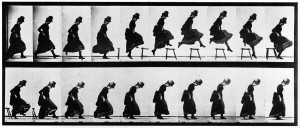Human movement is a dynamic and ephemeral phenomenon. It disappears without a trace and leaves no artifact behind. Consequently, movement has been very difficult to study. The means for capturing and preserving movement behavior in material forms are comparatively new and depend upon other extension systems. These include drawings and notations along with mechanical recordings such as instantaneous photography, film, video, and motion capture.
All extension systems amplify biological functions. For example, a knife does a better job of cutting than the teeth and a photograph extends the visual impressions of the eye. Yet extensions also have their limitations. A knife can cut, but unlike the teeth, it cannot chew. A camera lens can handle only a fraction of what the human eye does. As Edward Hall points out, “extensions are reductionist in their capabilities.”

Instantaneous photography, such as Eadweard Muybridge’s images of human and animal motion, is a case in point. In the late 1800s, these photographs created a sensation by capturing aspects of movement that the human eye could not perceive. At the same time, due to the time intervals between exposures, these images left out part of the action, creating a curiously static impression. For as Henri Bergson observed, “with immobility set beside immobility, even endlessly, we could never make movement.”
Due to the limited number of frames per second that could be recorded, early films were similarly flawed. Because the snapshots were shown in rapid succession, these films created a more realistic illusion of motion than instantaneous photographs. Nevertheless, part of the continuity of natural action was lost, and this is why the actor’s movements in silent films appear jerky and inadvertently humorous.
Contemporary film and video preserve the temporal continuity of movement better. Nevertheless, these images are projected on a flat screen and while they give the illusion of three dimensions, they are not, in fact, three-dimensional in the same way that real life movement is. Consequently, while these mechanical recordings of human motion are invaluable for movement study, it is important to remember that they have limitations, for part of the temporal continuity and three-dimensionality of movement is reduced. This requires adjustment for observers interested in fine detail and ephemeral aspects of movement, such as effort qualities.
